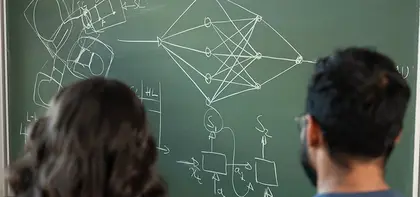
Hydrodynamic Limit
Microscopic evolution with thermal fluctuations on a discrete space...
On the microscopic scale, one considers an atomistic or mesoscopic model. There is a lot of freedom to choose the model, but to have an application in mind let us think of a spin system on a lattice. The microscopic evolution is usually governed by two mechanisms:
- an equilibration mechanism tries to minimize the energy of the microscopic system, and
- the thermal noise prevents the system of freezing in a local minimizer of the energy.
Because of the noise, the microscopic system may approach a statistical equilibrium state.
...lead to a macroscopic evolution without noise on a continuous space
Now, let's have a look at the microscopic system at a coarse scale. In our example this means looking at averages of spins gathered in blocks. By considering coarser and coarser scales, one observes two phenomena:
- The discrete lattice space approximates a continuous space, and
- the noise is getting smaller by an averaging effect. The stochastic evolution becomes more and more deterministic.
We want to answer the following questions:
- Is there a deterministic evolution on the continuous space that is approximated by the coarse-grained microscopic evolution?
- How is the deterministic evolution linked to the microscopic energy?
- How fast is the approximation?
- What are the statistics of the fluctuations around the deterministic evolution?
A two-scale approach
The two-scale approach [Reference 1] represents a general strategy to answer the questions from above. The main idea of the two-scale approach is to gain better understanding by considering the atomistic or mesoscopic system at two scales:
- the microscopic scale describes the fluctuation of the system around a macroscopic state,
- the macroscopic scale describes the coarsened macroscopic system.
An important ingredient is the fast equilibration on the microscopic scale; this means that the statistical equilibrium of the fluctuations is attained very fast. The fast equilibration allows to further neglect the microscopic scale.
By averaging, one can already assume that the evolution on the macroscopic scale is already deterministic. Now, one only has to identify the limit of the evolution on a discrete space that becomes more and more continuous.
Equilibration in high dimensions - the logarithmic Sobolev inequality
As outlined in the last section, it is very important to show that on the microscopic scale there is a fast equilibration. In the hydrodynamic limit, the system size goes to infinity. Therefore, it is important to measure the equilibration with a tool that is able to handle high dimensions. For that reason, we measure the equilibration with the help of the relative entropy, which is closely connected to the logarithmic Sobolev inequality. To have a sufficiently good equilibration, it is sufficient to show that the statistical equilibrium state of the microscopic system satisfies the logarithmic Sobolev inequality uniformly in the system size. This motivates our interest in deducing the logarithmic Sobolev inequality for several systems.
References and further reading
For a general introduction to the two-scale approach we recommend to read the article:
A two-scale approach to logarithmic Sobolev inequalities and the hydrodynamic limit
In: Annales de l'Institut Henri Poincaré / B, 45 (2009) 2, pp. 302-351For a general introduction to hydrodynamic limits, we recommend to read [1] and:
- S. R. S. Varadhan.
Relative entropy and hydrodynamic limits.
Stochastic processes, 329-336, Springer, New York, 1993.
For a general introduction to logarithmic Sobolev inequalities, we recommend to read:
- M. Ledoux.
Logarithmic Sobolev inequalities for unbounded spin systems revisited.
Sem. Probab. XXXV, Lecture Notes in Math., Springer 1755:167-194, 2011. - G. Royer.
Une initiation aux inégalités de Sobolev logarithmiques.
Cours Spécialisés, Soc. Math. de France, 1999.
Works of our research group connected to this research topic:
LSI for Kawasaki dynamics with weak interaction
Equilibrium dynamics of continuous unbounded spin systems
Dissertation, Rheinische Friedrich-Wilhelms-Universität Bonn, 2011Uniform logarithmic Sobolev inequalities for conservative spin systems with super-quadratic single-site potential.
A new criterion for the logarithmic Sobolev inequality and two applications
In: Journal of functional analysis, 243 (2007) 1, pp. 121-157Presentations
- Criteria for Logarithmic Sobolev Inequalities, Application to hydrodynamic limit (see PDF, 140 Kbyte)